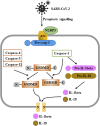The deadly coronaviruses: The 2003 SARS pandemic and the 2020 novel coronavirus epidemic in China
- PMID: 32143990
- PMCID: PMC7126544
- DOI: 10.1016/j.jaut.2020.102434
The deadly coronaviruses: The 2003 SARS pandemic and the 2020 novel coronavirus epidemic in China
Erratum in
-
Corrigendum to "The deadly coronaviruses: The 2003 SARS pandemic and the 2020 novel coronavirus epidemic in China" [J. Autoimmun. 109C (2020) 102434].J Autoimmun. 2020 Jul;111:102487. doi: 10.1016/j.jaut.2020.102487. Epub 2020 May 15. J Autoimmun. 2020. PMID: 32423578 Free PMC article. No abstract available.
Abstract
The 2019-nCoV is officially called SARS-CoV-2 and the disease is named COVID-19. This viral epidemic in China has led to the deaths of over 1800 people, mostly elderly or those with an underlying chronic disease or immunosuppressed state. This is the third serious Coronavirus outbreak in less than 20 years, following SARS in 2002-2003 and MERS in 2012. While human strains of Coronavirus are associated with about 15% of cases of the common cold, the SARS-CoV-2 may present with varying degrees of severity, from flu-like symptoms to death. It is currently believed that this deadly Coronavirus strain originated from wild animals at the Huanan market in Wuhan, a city in Hubei province. Bats, snakes and pangolins have been cited as potential carriers based on the sequence homology of CoV isolated from these animals and the viral nucleic acids of the virus isolated from SARS-CoV-2 infected patients. Extreme quarantine measures, including sealing off large cities, closing borders and confining people to their homes, were instituted in January 2020 to prevent spread of the virus, but by that time much of the damage had been done, as human-human transmission became evident. While these quarantine measures are necessary and have prevented a historical disaster along the lines of the Spanish flu, earlier recognition and earlier implementation of quarantine measures may have been even more effective. Lessons learned from SARS resulted in faster determination of the nucleic acid sequence and a more robust quarantine strategy. However, it is clear that finding an effective antiviral and developing a vaccine are still significant challenges. The costs of the epidemic are not limited to medical aspects, as the virus has led to significant sociological, psychological and economic effects globally. Unfortunately, emergence of SARS-CoV-2 has led to numerous reports of Asians being subjected to racist behavior and hate crimes across the world.
Keywords: Bats; Coronavirus; Epidemic; Epidemiology; Flu; Human to human transmission; Pandemic; Pneumonia; Pyroptosis; SARS-CoV; SARS-CoV-2.
Copyright © 2020 Elsevier Ltd. All rights reserved.
Conflict of interest statement
Declaration of competing interest The authors declare no conflict of interest.
Figures










Similar articles
-
[Etiology of epidemic outbreaks COVID-19 on Wuhan, Hubei province, Chinese People Republic associated with 2019-nCoV (Nidovirales, Coronaviridae, Coronavirinae, Betacoronavirus, Subgenus Sarbecovirus): lessons of SARS-CoV outbreak.].Vopr Virusol. 2020;65(1):6-15. doi: 10.36233/0507-4088-2020-65-1-6-15. Vopr Virusol. 2020. PMID: 32496715 Review. Russian.
-
The origin, transmission and clinical therapies on coronavirus disease 2019 (COVID-19) outbreak - an update on the status.Mil Med Res. 2020 Mar 13;7(1):11. doi: 10.1186/s40779-020-00240-0. Mil Med Res. 2020. PMID: 32169119 Free PMC article. Review.
-
Risk estimation of the SARS-CoV-2 acute respiratory disease outbreak outside China.Theor Biol Med Model. 2020 Jun 5;17(1):9. doi: 10.1186/s12976-020-00127-6. Theor Biol Med Model. 2020. PMID: 32498721 Free PMC article.
-
COVID-2019: update on epidemiology, disease spread and management.Monaldi Arch Chest Dis. 2020 Apr 16;90(1). doi: 10.4081/monaldi.2020.1292. Monaldi Arch Chest Dis. 2020. PMID: 32297723
-
Genomic characterisation and epidemiology of 2019 novel coronavirus: implications for virus origins and receptor binding.Lancet. 2020 Feb 22;395(10224):565-574. doi: 10.1016/S0140-6736(20)30251-8. Epub 2020 Jan 30. Lancet. 2020. PMID: 32007145 Free PMC article.
Cited by
-
Healthcare workers' compliance with COVID-19 prevention and control measures at De Martino Hospital, Mogadishu, Somalia: a cross-sectional study.BMC Infect Dis. 2024 Sep 27;24(1):1046. doi: 10.1186/s12879-024-09819-7. BMC Infect Dis. 2024. PMID: 39333892 Free PMC article.
-
Prediction of COVID-19 Hospitalization and Mortality Using Artificial Intelligence.Healthcare (Basel). 2024 Aug 26;12(17):1694. doi: 10.3390/healthcare12171694. Healthcare (Basel). 2024. PMID: 39273719 Free PMC article.
-
In silico analyses identify sequence contamination thresholds for Nanopore-generated SARS-CoV-2 sequences.PLoS Comput Biol. 2024 Aug 19;20(8):e1011539. doi: 10.1371/journal.pcbi.1011539. eCollection 2024 Aug. PLoS Comput Biol. 2024. PMID: 39159257 Free PMC article.
-
Antiviral Drug Discovery.Int J Mol Sci. 2024 Jul 6;25(13):7413. doi: 10.3390/ijms25137413. Int J Mol Sci. 2024. PMID: 39000520 Free PMC article.
-
COVID-19 Vaccine Hesitancy among Parents of Children Younger than 12 Years: Experience from a Tertiary Outpatient Clinic.Pharmacy (Basel). 2024 May 31;12(3):85. doi: 10.3390/pharmacy12030085. Pharmacy (Basel). 2024. PMID: 38921961 Free PMC article.
References
-
- Balasuriya U.B.R. List of contributors. In: MacLachlan N.J., Dubovi E.J., editors. Fenner's Veterinary Virology. fifth ed. Academic Press; Boston: 2017. pp. xvii–xviii.
Publication types
MeSH terms
LinkOut - more resources
Full Text Sources
Other Literature Sources
Miscellaneous

